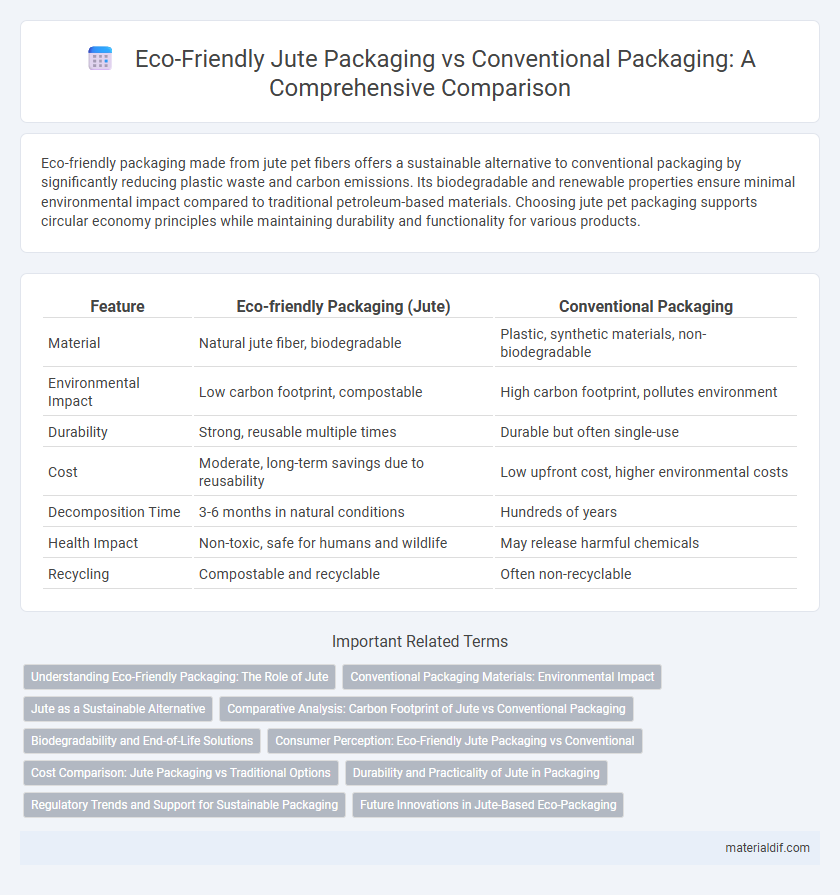Eco-friendly packaging made from jute pet fibers offers a sustainable alternative to conventional packaging by significantly reducing plastic waste and carbon emissions. Its biodegradable and renewable properties ensure minimal environmental impact compared to traditional petroleum-based materials. Choosing jute pet packaging supports circular economy principles while maintaining durability and functionality for various products.
Table of Comparison
| Feature | Eco-friendly Packaging (Jute) | Conventional Packaging |
|---|---|---|
| Material | Natural jute fiber, biodegradable | Plastic, synthetic materials, non-biodegradable |
| Environmental Impact | Low carbon footprint, compostable | High carbon footprint, pollutes environment |
| Durability | Strong, reusable multiple times | Durable but often single-use |
| Cost | Moderate, long-term savings due to reusability | Low upfront cost, higher environmental costs |
| Decomposition Time | 3-6 months in natural conditions | Hundreds of years |
| Health Impact | Non-toxic, safe for humans and wildlife | May release harmful chemicals |
| Recycling | Compostable and recyclable | Often non-recyclable |
Understanding Eco-Friendly Packaging: The Role of Jute
Jute, a biodegradable and renewable natural fiber, plays a crucial role in eco-friendly packaging by reducing plastic waste and lowering environmental pollution. Unlike conventional packaging materials such as plastic and synthetic fibers, jute decomposes rapidly and enriches soil health, making it an ideal sustainable alternative. Its high tensile strength and versatility enable manufacturers to produce durable bags, sacks, and wraps that minimize carbon footprint throughout the supply chain.
Conventional Packaging Materials: Environmental Impact
Conventional packaging materials such as plastic, Styrofoam, and non-recyclable composites contribute significantly to environmental pollution due to their non-biodegradable nature and long decomposition timelines, often exceeding hundreds of years. These materials generate substantial waste in landfill sites and ocean ecosystems, leading to harmful effects on wildlife and increased greenhouse gas emissions from production and disposal processes. The reliance on fossil fuels for manufacturing conventional packaging exacerbates carbon footprints, making their environmental impact considerably higher than eco-friendly alternatives like jute-based packaging.
Jute as a Sustainable Alternative
Jute stands out as a sustainable alternative in packaging due to its biodegradability, renewability, and low carbon footprint compared to conventional plastic-based materials. Unlike synthetic packaging, jute decomposes naturally without leaving harmful residues, significantly reducing environmental pollution and landfill waste. Its durability and reusability also support circular economy principles, enhancing eco-friendly packaging solutions globally.
Comparative Analysis: Carbon Footprint of Jute vs Conventional Packaging
Jute packaging produces significantly lower carbon emissions compared to conventional plastic and paper packaging, as it is biodegradable and requires less energy during production. The carbon footprint of jute is reduced by its renewable sourcing and minimal chemical inputs, contrasting sharply with the fossil fuel-dependent lifecycle of plastic materials. Lifecycle assessments consistently show jute packaging reduces greenhouse gas emissions by up to 50% compared to conventional packaging options.
Biodegradability and End-of-Life Solutions
Jute packaging offers superior biodegradability compared to conventional plastic packaging, breaking down naturally within months without releasing harmful microplastics. End-of-life solutions for jute include composting and recycling, which minimize environmental impact by returning organic matter to the soil. Conversely, traditional plastic often persists for centuries, contributing significantly to landfill accumulation and environmental pollution.
Consumer Perception: Eco-Friendly Jute Packaging vs Conventional
Consumer perception strongly favors eco-friendly jute packaging due to its sustainability, biodegradability, and natural aesthetic appeal compared to conventional plastic or synthetic materials. Studies indicate that shoppers associate jute packaging with environmental responsibility, leading to increased brand loyalty and willingness to pay a premium. The growing awareness of plastic pollution drives demand for jute as a renewable, compostable alternative that supports eco-conscious purchasing decisions.
Cost Comparison: Jute Packaging vs Traditional Options
Jute packaging offers a cost-effective alternative to conventional packaging materials such as plastic and paper, with raw material costs often lower due to the abundance and renewability of jute fibers. The durability and reusability of jute bags reduce the need for frequent replacements, decreasing long-term expenses for businesses. While initial production costs might be slightly higher, the overall lifecycle cost of jute packaging significantly undercuts traditional options, making it an economically sustainable choice.
Durability and Practicality of Jute in Packaging
Jute packaging offers superior durability compared to conventional plastic and paper alternatives, with natural fibers providing high tensile strength and resistance to wear and tear. Its practicality is enhanced by biodegradability, moisture resistance, and breathability, making it ideal for agricultural and retail packaging. Jute's ability to be reused multiple times without losing structural integrity supports sustainable packaging solutions.
Regulatory Trends and Support for Sustainable Packaging
Regulatory trends increasingly favor eco-friendly packaging, with governments worldwide imposing stricter regulations on single-use plastics and encouraging biodegradable alternatives like jute. Policies such as the European Union's directive on reducing packaging waste and incentives for sustainable material use highlight growing institutional support for eco-friendly solutions. Investments and subsidies targeting jute packaging promote compliance with environmental standards while advancing circular economy goals.
Future Innovations in Jute-Based Eco-Packaging
Future innovations in jute-based eco-packaging emphasize enhanced durability, water resistance, and biodegradability, positioning jute as a sustainable alternative to plastic and synthetic materials. Advanced chemical treatments and hybrid composites with natural fibers improve jute's performance for diverse packaging applications. Integration of smart technologies, such as embedded sensors for freshness and RFID tracking, further elevates jute packaging's functionality in the evolving green supply chain.
Eco-friendly Packaging vs Conventional Packaging Infographic

 materialdif.com
materialdif.com